Sathya Sai Baba's Birth Date is contested as also indicated clearly by his school records
Use right click here - then 'Open page in new window' to translate
Since 1950 Sai Baba’s birthday has been celebrated on Monday, November 23, 1926. He said he declared his divinity in May 1940, leaving leave home to start his ‘Mission’ later that year (October 20, 1940). The dating of these events is in doubt, because documentary and diverse circumstantial evidence makes it most likely that his birth date has been falsified.
Reasons why those wishing to promote him as the holiest Indian avatar, the first major such for millennia, and to select November 23, 1940 for his birthday were:-
1) that it had the signs of unusual astrological auspiciousness - very important for would-be ‘holy men’. However, no birth chart was made for Sathya Narayana Raju, not until decades later, when his endorsers set out to prove on the Internet that he possessed a remarkable personality. (See a late birth chart here)
2) Since Sathya Sai proclaimed he was omniscient, a proven wrong birth date would be highly embarrassing. According to one source, he had stated: "I resolved on my birth. I decided who should be my mother." Thus answered Swami to a question from the editor of the "Nav Kaal" (New Age) on the last day of December 1970 in Bombay, India. Baba went on to say that Rama and Krishna also chose their mothers.
3) Sri Aurobindo, much revered as an Indian ‘saint’, declared that November 24, 1926 saw the descent of Krishna into the physical. Though his followers maintain that he was referring to his own body, having been in a very long-lasting meditative trance until November 24 when he made his declaration, biographers and devotees of Sathya Sai Baba claimed that Aurobindo's statement must only refer to their Lord and Master. That there is a discrepancy of one day between the two dates, though it is only a matter of hours earlier, is of some importance. Nonetheless, Professor Kasturi strongly promoted the connection in his official biography, Sathya, Sivam, Sundaram - Volume , p.208, where he wrote:-
"One fact is interesting and may be mentioned here, since it has provoked many into a very profitable line of thought. I shall quote the letter written by one such inquirer, R. Ganapathi of the 'Kalki'. "Sri Aurobindo, who by the power of his integral Yoga delved into the Cosmic Mind was suddenly absorbed in an intense awareness of the Supramental Light's descent into the earth-consciousness. On page 208, of the book, 'Sri Aurobindo on Himself and the Mother' (1953 Edition), it is said, '24th November, 1926, was the descent of Krishna into the physical.' 'A power infallible shall lead the thought, in earthly hearts kindle the Immortal's Fire, Even the Multitude shall hear the Voice!' It is almost certain that the Descent noted by Sri Aurobindo was the Incarnation the previous day, November 23, 1926, of Sri Sathya Sai Baba."
"Almost certain" wrote Kasturi, who already believed fully that Sathya was the Divine Incarnation of Krishna. Of course, 100% certainty that Aurobindo was referring to Sathya cannot be established. The extreme closeness of the dates (one day apart) seems to be more than coincidental, so fraud by Sai Baba and Co. provides one rational and feasible explanation. Supporting this suspicion, a veritable mass of disinformation and false statements have been shown to have been employed throughout his life by his adherents, and not altered by the responsible persons even when major documentary proof and testimony was provided.
The Danish seeker and Sai Baba devotee, Birgitte Rodriguez, wrote a book ('Glimpses of the Divine'). Though it contains many fanciful reports, she did present clear documentation from Sri Aurobindo to refute the major claim by the Sathya Sai Organization and devotees, that Aurobindo was prophesying his 'descent as avatar' and Krishna reborn into the material world (24-10-1926). She convinces that Aurobindo was not referring to Sai Baba. (See here)
 Another indication that Sathya Sai Baba was considerably younger than he claimed was inadvertently given by his official biographer, N. Kasturi, who never questioned him seriously about his alleged birth date and other such discrepancies or ‘sensitive’ claims. See text scan here – right – where Kasturi’s first impression when meeting Baba on moving to Prashanthi Nilayam in 1948 was that he was much younger than claimed – which sheds new light on the school record documents which puts his birth date at October 4, 1929… three years later than Sai Baba claimed. Hence, Sai Baba could boast of greater youthfulness than was the fact, putting it down to his Krishna-like eternal youthfulness' and purity. Following Kasturi’s ever-repeated lead, blind devotees would put everything inexplicable down to ‘His Mystery’ and call it “His divine leela” or the like.
Another indication that Sathya Sai Baba was considerably younger than he claimed was inadvertently given by his official biographer, N. Kasturi, who never questioned him seriously about his alleged birth date and other such discrepancies or ‘sensitive’ claims. See text scan here – right – where Kasturi’s first impression when meeting Baba on moving to Prashanthi Nilayam in 1948 was that he was much younger than claimed – which sheds new light on the school record documents which puts his birth date at October 4, 1929… three years later than Sai Baba claimed. Hence, Sai Baba could boast of greater youthfulness than was the fact, putting it down to his Krishna-like eternal youthfulness' and purity. Following Kasturi’s ever-repeated lead, blind devotees would put everything inexplicable down to ‘His Mystery’ and call it “His divine leela” or the like.
No one can be 100% sure of any facts that are promulgated by Sai Baba or his various promoters, and the evidence is inconclusive for a large number of reported 'facts' from his early years. His school record may just as well have have been contrived at the time, since - as many of his worshipping defenders have also argued - very few people in the primitive village Puttaparthi in the 1920s had any relationship to calendar dates - the Western calendar was never prominent in the village culture of that time. When school authorities wanted dates, these would have been estimates or guesses, even fixed to prove eligibility for school, certain class levels or exams etc. However, there could have been exceptions, as in the register where a definite date was recorded for SB. Mr. Padmanabhan, the author of 'Love is My Form' commented on the scans there as follows:-
"Sathya's date of birth in school records, however, is
recorded as the 4"” of October l929-and not the
traditionally recognised date of the 23"’ of November I926. Talipineni Kesappa. son of Talipineni Ramappa
maintains that Sathya was one year senior to him at
school: therefore. Kesappa's date of birth being the I l"‘
of June I927. Sathya's year of birth definitely is I926. It
has long been a practice in the schools to record a date
of birth as being much later than the ‘actual’ date of
birth-in order to facilitate career prospects. Sathya's
parents wanted Sathya to become an educated officer.
This. possibly. could be the reason for the discrepancy.
In addition. in I926. people in remote villages like
Puttaparthi. in pre-independent India. were not very
particular about dates and birth registration was done
much later." (View school register)
Drawing such a definitive conclusion, however, from the memory of a single fellow student among a number such also interviewed for the book seems hasty and - since the author is a devotee - appears as an attempt to rationalize away the data and the circumstantial evidence that support it as listed here. Besides, Kesappa may well have not wanted to upset the apple cart for himself and family, and instead of drawing down censure from the ashram, giving that testimony may even have had positive consequences for him.) 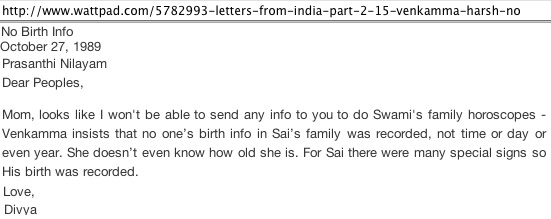
Eileen Weed ('Divya'), the former devotee from the US in Puttaparthi for most of 2 decades and who lived for long periods with Sai Baba's elder sister, Venkamma, and knew his other sister Parvatamma well, often spoke with family members about their birth dates, as seen in the scan of one of her on-line letters home to her parents she recorded some important information:-
Eileen Weed also informed me:- "...villagers did not have clocks so didn't know the time of day - they only went by references to festivals when remembering the birth of a child (and particular years could not be accurately recalled years later). As an afterthought, Venkamma did tell me that there were special signs so Sai's birth info might have been noted down - but she was over 70 by then, and might have been influenced by decades of heresy and the need to protect the myth around her brother. Even if it was recorded, it is unlikely that it would be the right info, as villagers were very much cut off from exact times and dates.
What a pity that her original writings and the copy given to Mrs. Ratanlal, was conveniently "lost" - both by her own grandson and PN VIPs! Those writings would have revealed a lot because they were so mundane and insubstantial!
The Cambridge academic, Brian Steel, presents additional strong circumstantial evidence to support the proposition that Satya Narayana Raju was not born in 1926:
"This 'Declaration of Mission' has always been dated in the SB literature and in SSO celebrations and references as 20 October 1940 (when SB was allegedly one month from his 14th birthday). The Golden Jubilee was officially celebrated by the SSO in 1990.
However, the publication in October 2000 of the meticulously researched first volume of a planned definitive 6-volume biography of SB by the well-known Puttaparthi publisher Sai Towers, Love is My Form, shows the quoted 1940 to be three years premature. This evidence changes the chronology of the early years of SB's Mission. In fact, SB spent the school years 1936-1940 in the Elementary School in Puttaparthi, and the year 1940-1941, not engaged on his Mission, as we have been told by all previous commentators, but in Form One of the Middle School at Kamalapura, some 200 kilometres from Puttaparthi, where his elder brother, Seshama, had begun his teaching career."
"Although the editors of LIMF are at pains (on p. 149) to deny that the 3 year discrepancy in the new date for the Declaration is of any importance, their argument is unconvincing: "Indian spirituality tends to discourage numerous debates on scholarly details relating to time and space. Sri Sathya Sai Baba also disapproves of such debates. ..." (see more at http://bdsteel.tripod.com/More/Omnitruth.htm also Specific Discrepancies in the Official SSB Biography and here below:-
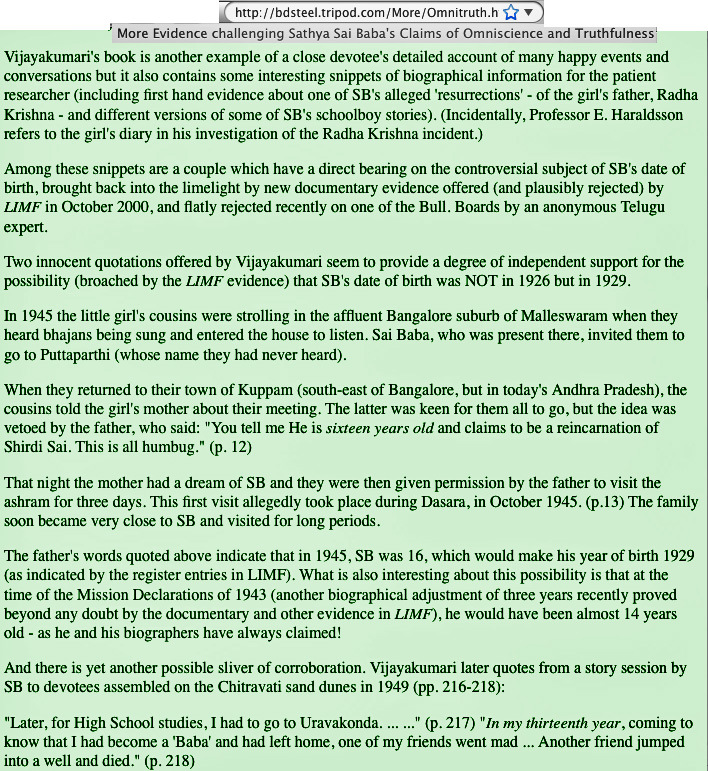
For a 'remarkable' birth one would expect that people would have remarked on it at the time. Reportedly, his mother, Eashwaramma, spoke in public about the blue light that supposedly entered her at the well in Puttaparthi at the alleged 'divine inception' of the child before the birth many years later, and reportedly only when asked by SB to tell it. The mythology of his first days was almost certainly developed much later (the cobra rocking his cradle, the instruments that played themselves etc.) and were much later said never to have happened, both by his elder brother and his sisters. The elder brother also said that cobras were common there then and often went past the door, while instruments hanging on the wall could sound in the wind as the house was often open to the street. Cobras were found inside ground floor apartments at the ashram twice when my wife and I were staying there, and one once fell from the trees near my wife in the darsan compound in the 1980s.
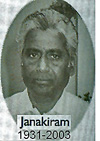 Here is a photo scan from 'Love is My Form' stating the age and life span of Sai Baba's younger brother Janaki Ramiah. That Sai Baba could have been born years late than 1926 does not conflict with that. Moreover, a six year gap between Sathya and Janaki does seem rather too long a spell. According to Sai Baba's chosen biographer Kasturi, Easwaramma had already had her two daughters plus four abortive pregnancies before Sathya was born. Here is a photo scan from 'Love is My Form' stating the age and life span of Sai Baba's younger brother Janaki Ramiah. That Sai Baba could have been born years late than 1926 does not conflict with that. Moreover, a six year gap between Sathya and Janaki does seem rather too long a spell. According to Sai Baba's chosen biographer Kasturi, Easwaramma had already had her two daughters plus four abortive pregnancies before Sathya was born.
The date of Sathya Sai's birth is also ostensibly contradicted by his school records. The major biographical work promoting him as an avatar is "Love is My Form", Vol 1. (Sai Towers, October 2000), compiled and published by Padmanabhan of Puttaparthi, contains much meticulous research, while also promoting much to glorify him that is doubtful and unproven. Some of the documented evidence is in serious conflict with various statements often repeated by Sathya Sai Baba in his discourses, as also promoted widely by the Sathya Sai Organization. His accounts of the date of his declaration of his 'Divine Mission' (20 October 1940) made it clear that he threw away his schoolbooks while on the way to school, but the date given was a Sunday - not a Monday as stated, and there would have been no school on that date. This shows further why Sai Baba's claims on dates are untrustworthy.
|
The Indian Skeptic posted a summary
of the evidence about his school records
etc. in 2008, as scanned here:-
 |
The School Register photostat evidence makes it clear that he was not even attending the school when the examinations in which he later often related how he cheated on behalf of two of his classmates.
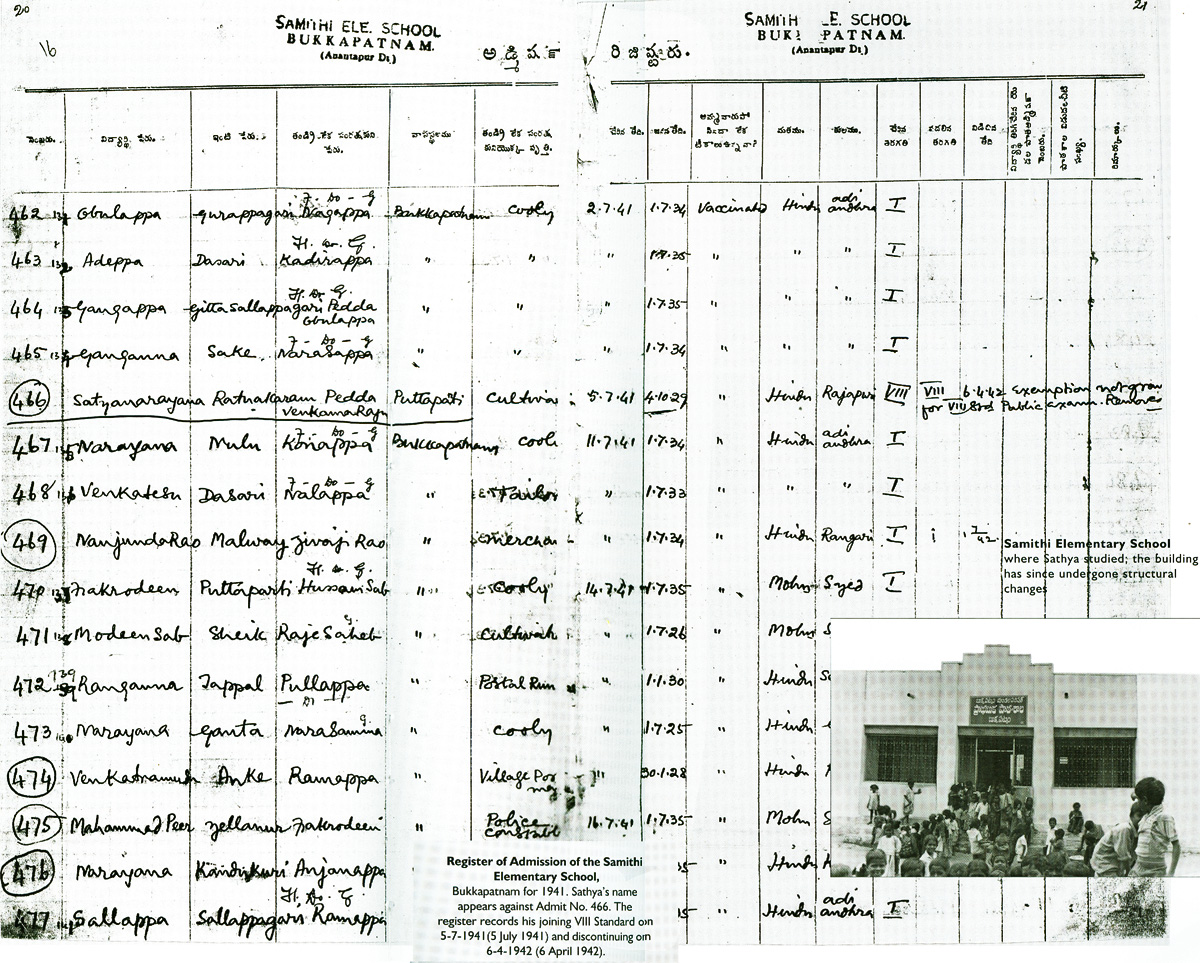
saibabaexpose.wordpress.com remarked:-
“A major problem in trying to understand Sathya Sai Baba’s life relates to relying heavily on ‘official’ material, such as the authorized ‘Sathyam Sivam Sundaram’ hagiography by N. Kasturi, whose authenticity and reliability have come under serious scrutiny. A common misconception relating to the young Sai Baba (as Sathyanarayana Raju) is the assumption of his continuance of education in nearby Bukkapatnam, all because it happens to be the neighbouring town. Meticulous research by way of analyzing all of Raju’s available school records show his education movements as follows:-
Puttaparthi – Kamalapuram – Bukkapatnam – Uravakonda
The reason given to account for such upheaval relates to how Raju’s parents entrusted the responsibility of his education to their eldest son, Seshama, who was a teacher by occupation and was himself frequently transferred around the district to teach. Consequently Raju followed his brother and lived in the same house along with him, his sister-in-law and her relatives. And so Raju was transferred from the Government-aided Elementary School in Puttaparthi to the Board Middle School in Kamalapuram. Thanks to Seshama’s disruptive transfers, he was transferred from there to the Samithi Elementary School at Bukkapatnam.
• Text on left of certificate reads:-
• Name of the school which the pupil is leaving: B.M. School Kamalapuram
• Name of the pupil: Ratnakaram Satyanarayana
• Date of birth as entered in the admission register: 4.10.1929 (Fourth October Nineteen Twenty Nine)
• Class or form in which the pupil was [unintelligible] at the time of leaving (in words): First Form
• Date of admission or promotion to that class or form: 11.6.40
• Date when the pupil actually left the school: 22.4.41
• Date on which application for transfer certificate was made on behalf of the pupil by the parent or guardian: 20.6.41
• Date of transfer certificate: 20.6.41″ |
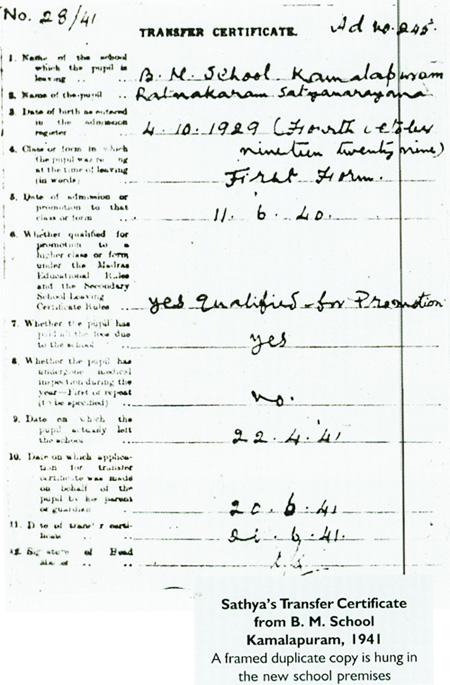 |
Return to index menu
 Another indication that Sathya Sai Baba was considerably younger than he claimed was inadvertently given by his official biographer, N. Kasturi, who never questioned him seriously about his alleged birth date and other such discrepancies or ‘sensitive’ claims. See text scan here – right – where Kasturi’s first impression when meeting Baba on moving to Prashanthi Nilayam in 1948 was that he was much younger than claimed – which sheds new light on the school record documents which puts his birth date at October 4, 1929… three years later than Sai Baba claimed. Hence, Sai Baba could boast of greater youthfulness than was the fact, putting it down to his Krishna-like eternal youthfulness' and purity. Following Kasturi’s ever-repeated lead, blind devotees would put everything inexplicable down to ‘His Mystery’ and call it “His divine leela” or the like.
Another indication that Sathya Sai Baba was considerably younger than he claimed was inadvertently given by his official biographer, N. Kasturi, who never questioned him seriously about his alleged birth date and other such discrepancies or ‘sensitive’ claims. See text scan here – right – where Kasturi’s first impression when meeting Baba on moving to Prashanthi Nilayam in 1948 was that he was much younger than claimed – which sheds new light on the school record documents which puts his birth date at October 4, 1929… three years later than Sai Baba claimed. Hence, Sai Baba could boast of greater youthfulness than was the fact, putting it down to his Krishna-like eternal youthfulness' and purity. Following Kasturi’s ever-repeated lead, blind devotees would put everything inexplicable down to ‘His Mystery’ and call it “His divine leela” or the like.




